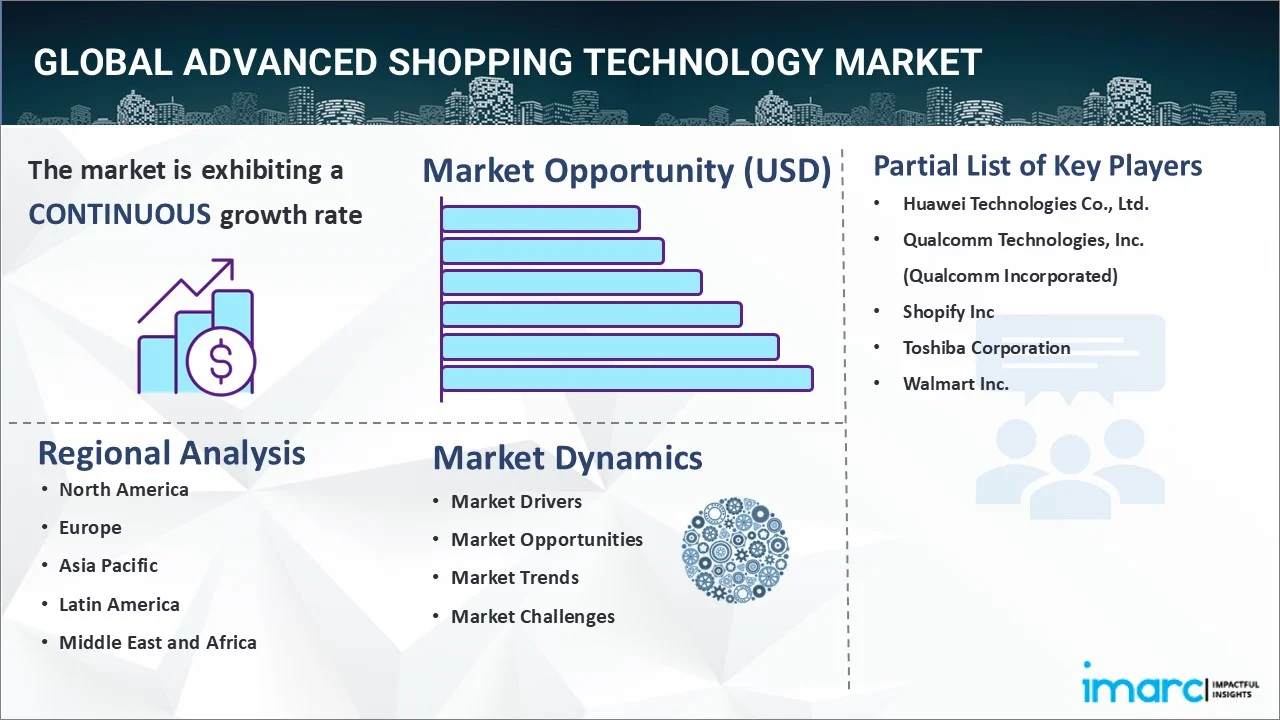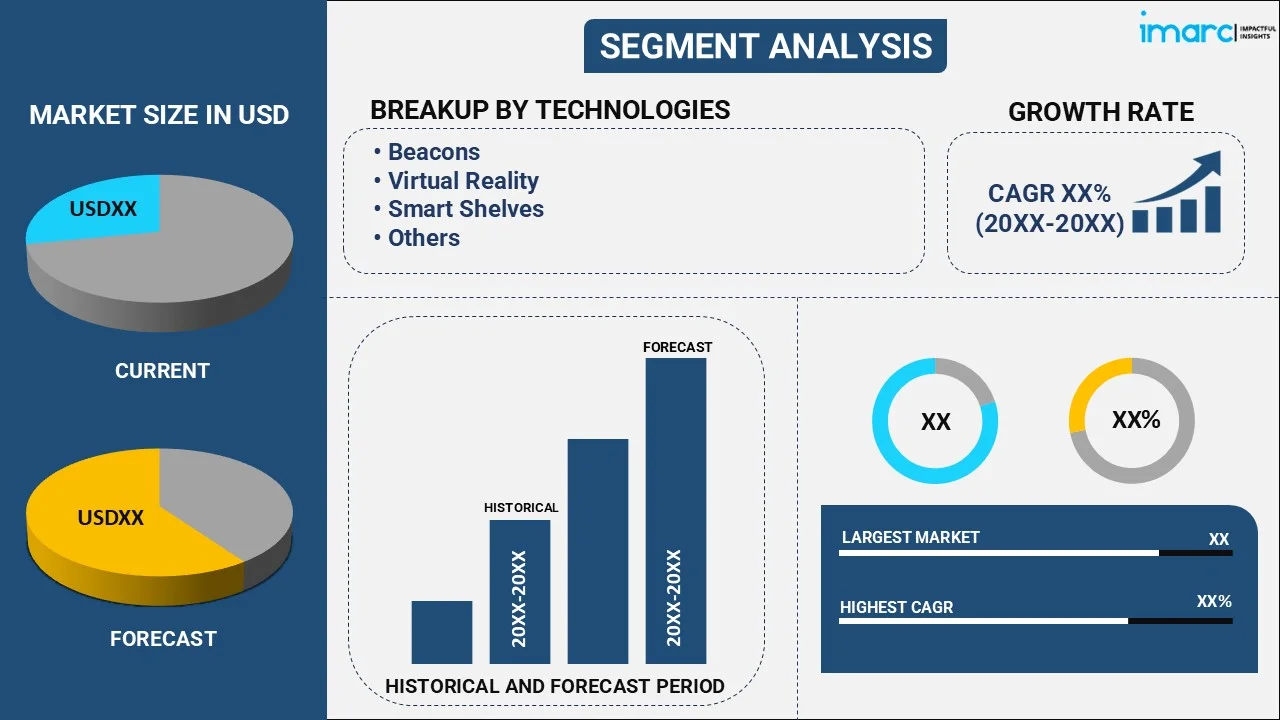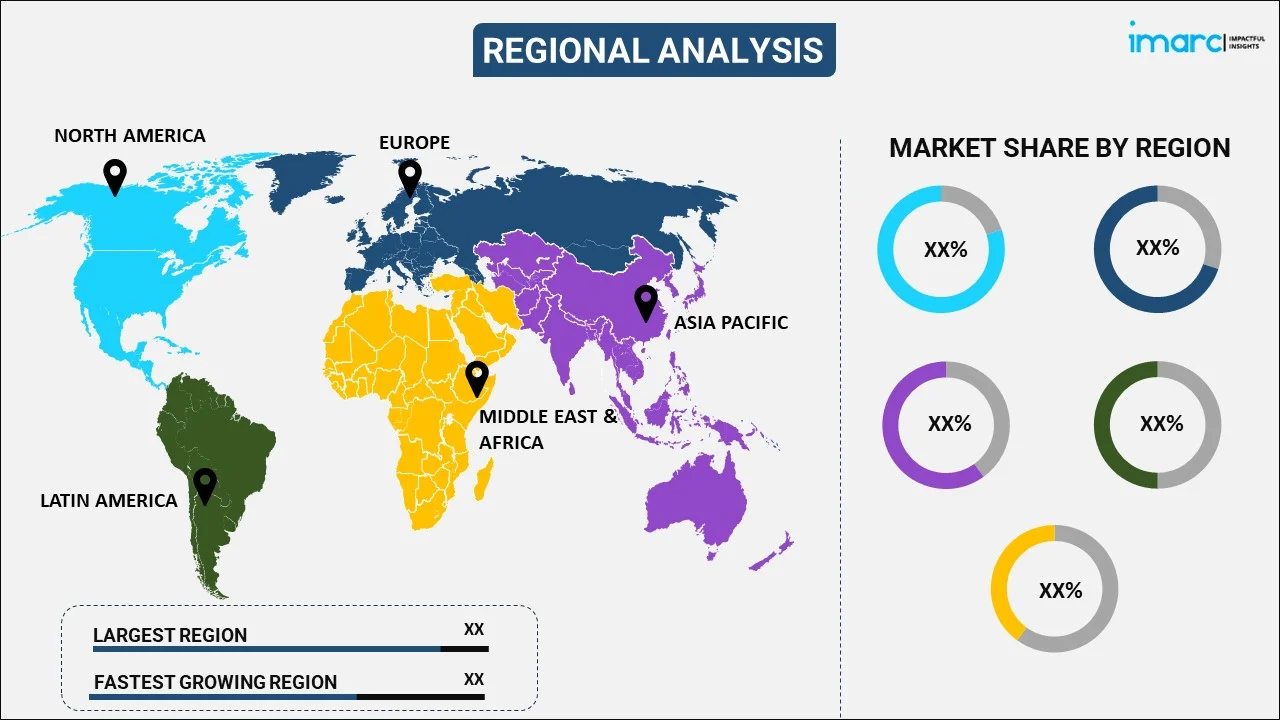
Advanced Shopping Technology Market Report by Technology (Beacons, Virtual Reality, Smart Shelves, Retail Apps, Social Media and Showrooming, and Others), Application (Retail, Commercial Advertising, and Others), and Region 2025-2033
Advanced Shopping Technology Market Size:
The global advanced shopping technology market size reached USD 14.2 Billion in 2024. Looking forward, IMARC Group expects the market to reach USD 48.3 Billion by 2033, exhibiting a growth rate (CAGR) of 13.5% during 2025-2033. The shift towards contactless shopping experiences, the rising demand for real-time analytics to understand customer behavior, and rapid technological advancements are some of the major factors propelling the market. At present, North America holds the largest market share, driven by high smartphone penetration and widespread internet connectivity.
|
Report Attribute
|
Key Statistics
|
|---|---|
|
Base Year
|
2024
|
|
Forecast Years
|
2025-2033
|
|
Historical Years
|
2019-2024
|
|
Market Size in 2024
|
USD 14.2 Billion |
|
Market Forecast in 2033
|
USD 48.3 Billion |
| Market Growth Rate 2025-2033 | 13.5% |
Advanced Shopping Technology Market Analysis:
- Major Market Drivers: The increasing demand for personalized shopping experiences is fueling the advanced shopping technology market growth. Moreover, the rise of e-commerce and omnichannel strategies, as well as the growing preference among consumers for seamless shopping, is boosting growth in the market.
- Key Market Trends: The major market trends include the introduction of artificial intelligence (AI)-powered recommendations, augmented reality (AR) try-ons, and cashier-less checkout systems in the retail sector. Additionally, the burgeoning integration of advanced analytics by retailers to track consumer behavior and optimize inventory management, is favoring the market growth.
- Geographical Trends: North America is leading in the adoption of advanced shopping technologies due to a highly developed retail infrastructure and tech-savvy consumers. Other regions are also experiencing growth as a result of rapid digital transformation and increasing internet penetration.
- Competitive Landscape: Some of the major market players in the advanced shopping technology industry include Huawei Technologies Co., Ltd., Qualcomm Technologies, Inc. (Qualcomm Incorporated), Shopify Inc, Toshiba Corporation, Walmart Inc., among many others.
- Challenges and Opportunities: The advanced shopping technology market analysis indicate that data privacy concerns and high implementation costs are major hurdles impeding the market growth. However, the growing focus on enhancing customer engagement and reducing operational costs is presenting immense opportunities for technological innovation in retail.

Advanced Shopping Technology Market Trends:
Increasing Demand for Personalized Shopping Experience
In the contemporary digital age, customers are seeking products or services and personalized experiences that resonate with their preferences. This escalating demand is a major driver for advanced shopping technology market share. Advanced algorithms powered by artificial intelligence (AI) and machine learning (ML) are capable of analyzing large amounts of data about consumer behavior and preferences. These insights can be used to curate personalized product recommendations, targeted advertising, and custom promotional offers. This level of personalization often results in enhanced customer engagement and loyalty, ultimately leading to increased sales and revenue for businesses. As consumers continue to demand more tailored experiences, the adoption of advanced shopping technology that facilitates such personalization is likely to expand.
Growth of the E-commerce Sector
The rapid growth of the e-commerce industry globally is another key driver for the advancement of shopping technology. As more consumers opt for online shopping due to its convenience and variety, businesses are compelled to adopt sophisticated digital tools to ensure a seamless and engaging online shopping experience. These tools include virtual and augmented reality (VR/AR) for virtual try-on experiences, chatbots for real-time customer service, advanced payment systems for secure transactions, and supply chain technologies for efficient product delivery. Along with this, the rise of e-commerce has increased competition among businesses, necessitating the implementation of advanced shopping technology to stay competitive.
Continuous Technological Advancements
The continuous advancement in technology, particularly in the fields of artificial intelligence, machine learning, data analytics, and the Internet of Things (IoT), has facilitated the development of more sophisticated shopping technologies. In confluence with this, these advancements have enabled retailers to capture and analyze customer data more effectively, predict future shopping trends, optimize pricing strategies, manage inventory more efficiently, and provide more secure payment options. In addition, improvements in augmented reality and virtual reality technologies have allowed businesses to create immersive virtual shopping experiences. As technology continues to evolve, it is also driving the advanced shopping technology market growth.
Advanced Shopping Technology Market Segmentation:
IMARC Group provides an analysis of the key trends in each segment of the market, along with forecasts at the global, regional, and country levels for 2025-2033. Our report has categorized the market based on technology and application.
Breakup by Technology:

- Beacons
- Virtual Reality
- Smart Shelves
- Retail Apps
- Social Media and Showrooming
- Others
The report has provided a detailed breakup and analysis of the market based on the technology. This includes beacons, virtual reality, smart shelves, retail apps, social media and showrooming, and others.
The advanced shopping technology market insights indicate that virtual reality (VR) technology has emerged as a compelling segment in the industry. With the rapid advancement of VR capabilities, consumers are increasingly seeking immersive and personalized shopping experiences. VR enables retailers to create lifelike simulations, allowing customers to virtually try out products, explore stores, and engage with interactive content. This enhanced shopping journey not only boosts consumer engagement and satisfaction but also fosters a deeper emotional connection with brands. Additionally, the growing trend of e-commerce and the need for differentiation among retailers are fueling the demand for innovative solutions.
On the other hand, the proliferation of smartphones and the increasing adoption of mobile devices have fundamentally transformed consumer behavior and expectations. Retail apps offer a convenient and seamless shopping experience, allowing customers to browse, purchase, and track orders on-the-go. The integration of personalized recommendations, loyalty programs, and mobile payment options further enhances customer engagement and loyalty. Moreover, the COVID-19 pandemic accelerated the demand for contactless shopping solutions, making retail apps a compelling choice for both retailers and consumers.
Breakup by Application:
- Retail
- Commercial Advertising
- Others
A detailed breakup and analysis of the market based on the application have also been provided in the report. This includes retail, commercial advertising, and others.
Retail applications are experiencing robust growth in the industry. As the retail landscape continues to evolve, consumer preferences are shifting towards seamless, efficient, and personalized shopping experiences. Retail applications offer a comprehensive solution to meet these demands by providing customers with easy access to a wide range of products, real-time inventory updates, and personalized recommendations based on their shopping behavior. In confluence with this, the growing penetration of smartphones and the widespread availability of high-speed internet that fuel the popularity of retail apps, enabling consumers to shop anytime and anywhere is contributing to the advanced shopping technology market growth. Moreover, retailers are recognizing the value of data-driven insights obtained through these applications, which empower them to tailor their marketing strategies and optimize inventory management.
On the other hand, commercial advertising applications are witnessing significant market drivers in the advanced shopping technology industry. As businesses seek innovative ways to engage with their target audiences, commercial advertising applications have emerged as powerful tools to deliver targeted and relevant ads. These applications leverage sophisticated data analytics and machine learning (ML) algorithms to understand consumer preferences and behavior, enabling advertisers to deliver personalized content. In addition, the rise of mobile devices and the increasing time spent on digital platforms have created vast opportunities for advertisers to reach consumers on-the-go. The ability to measure ad performance in real-time and optimize campaigns based on actionable insights has further fueled the adoption of commercial advertising applications.
Breakup by Region:

- North America
- United States
- Canada
- Europe
- Germany
- France
- United Kingdom
- Italy
- Spain
- Others
- Asia Pacific
- China
- Japan
- India
- South Korea
- Australia
- Indonesia
- Others
- Latin America
- Brazil
- Mexico
- Others
- Middle East and Africa
North America leads the market, accounting for the largest advanced shopping technology market share
The report has also provided a comprehensive analysis of all the major regional markets, which include North America (the United States and Canada); Europe (Germany, France, the United Kingdom, Italy, Spain, and others); Asia Pacific (China, Japan, India, South Korea, Australia, Indonesia, and others); Latin America (Brazil, Mexico, and others); and the Middle East and Africa. According to the report, North America represents the largest regional market for advanced shopping technology.
As per the advanced shopping technology market analysis, North America is experiencing robust growth, fueled by the region's high smartphone penetration and widespread internet connectivity. Consumers' increasing reliance on mobile devices has driven the demand for mobile shopping applications, virtual reality (VR) experiences, and augmented reality (AR) solutions. Additionally, the COVID-19 pandemic has accelerated the shift towards contactless and online shopping, prompting retailers to invest in advanced technologies to meet changing consumer preferences. Along with this, the rising consumer expectations for personalized, seamless, and convenient shopping experiences have led retailers to embrace artificial intelligence (AI), data analytics, and machine learning (ML) to offer tailored recommendations and improve customer engagement.
On the contrary, the Asia Pacific region is witnessing growth in the industry, fueled by the region's burgeoning middle-class population and rapid urbanization. As a result, retailers are investing in advanced technologies such as mobile apps, VR, and AI to cater to the diverse and evolving needs of consumers. In addition, the widespread adoption of smartphones and internet connectivity in countries across the region has paved the way for mobile commerce to flourish. This has prompted retailers to develop user-friendly mobile applications and implement mobile payment solutions to enhance convenience and accessibility. Furthermore, the growing popularity of e-commerce platforms that necessitate the integration of cutting-edge technologies to provide a seamless and personalized shopping journey, is enhancing the advanced shopping technology market share.
Competitive Landscape:
- The market research report has also provided a comprehensive analysis of the competitive landscape in the market. Detailed profiles of all major companies have also been provided. Some of the major market players in the advanced shopping technology industry include Huawei Technologies Co., Ltd., Qualcomm Technologies, Inc. (Qualcomm Incorporated), Shopify Inc, Toshiba Corporation, Walmart Inc., etc.
(Please note that this is only a partial list of the key players, and the complete list is provided in the report.)
- The global advanced shopping technology market is experiencing significant growth due to rising investments in the creation of user-friendly and feature-rich mobile applications and online platforms. These apps offer personalized recommendations, real-time inventory updates, and seamless checkout processes to enhance customer convenience. Along with this, the incorporation of VR and AR technologies into their shopping experiences to try out products, visualize how items will look in homes, and experience immersive brand storytelling is positively influencing the advanced shopping technology market growth. In addition, companies are leveraging data analytics and ML to gain insights into consumer behavior, preferences, and shopping patterns, which is acting as another growth-inducing factor. Apart from this, the widespread adoption of AI to enhance customer service through chatbots and virtual assistants, provide personalized product recommendations, and optimize supply chain management is significantly supporting the market. Furthermore, the escalating focus on eco-friendly packaging, promoting responsible manufacturing processes, and supporting fair trade practices is contributing to the market.
Advanced Shopping Technology Market News:
- In February 2024, Huawei released the Smart Retail Solution, which is designed for retail campuses, stores, and multi-branch interconnection. This series focuses on smart stores, intelligent warehousing, energy efficiency, and digital marketing. It also employs the latest Wi-Fi, storage, cloud, and Internet of Things (IoT) technologies to help retail companies increase efficiency, reduce costs, and improve consumer experience.
- In September 2024, Qualcomm Technologies, Inc. and Honeywell collaborated to develop an artificial intelligence (AI)-enabled multi-modal intelligent agent for Honeywell mobile devices. This agent will allow workers and customers in the distribution center and retail industries to interact naturally with their handheld devices through voice, pictures, and barcodes.
Advanced Shopping Technology Market Report Scope:
| Report Features | Details |
|---|---|
| Base Year of the Analysis | 2024 |
| Historical Period | 2019-2024 |
| Forecast Period | 2025-2033 |
| Units | Billion USD |
| Scope of the Report | Exploration of Historical and Forecast Trends, Industry Catalysts and Challenges, Segment-Wise Historical and Predictive Market Assessment:
|
| Technologies Covered | Beacons, Virtual Reality, Smart Shelves, Retail Apps, Social Media and Showrooming, Others |
| Applications Covered | Retail, Commercial Advertising, Others |
| Regions Covered | Asia Pacific, Europe, North America, Latin America, Middle East and Africa |
| Countries Covered | United States, Canada, Germany, France, United Kingdom, Italy, Spain, China, Japan, India, South Korea, Australia, Indonesia, Brazil, Mexico |
| Companies Covered | Huawei Technologies Co., Ltd., Qualcomm Technologies, Inc. (Qualcomm Incorporated), Shopify Inc, Toshiba Corporation, Walmart Inc., etc. |
| Customization Scope | 10% Free Customization |
| Post-Sale Analyst Support | 10-12 Weeks |
| Delivery Format | PDF and Excel through Email (We can also provide the editable version of the report in PPT/Word format on special request) |
Key Questions Answered in This Report:
- How has the global advanced shopping technology market performed so far, and how will it perform in the coming years?
- What are the drivers, restraints, and opportunities in the global advanced shopping technology market?
- What is the impact of each driver, restraint, and opportunity on the global advanced shopping technology market?
- What are the key regional markets?
- Which countries represent the most attractive advanced shopping technology market?
- What is the breakup of the market based on the chemistry?
- Which is the most attractive chemistry in the advanced shopping technology market?
- What is the breakup of the market based on the application?
- Which is the most attractive application in the advanced shopping technology market?
- What is the competitive structure of the global advanced shopping technology market?
- Who are the key players/companies in the global advanced shopping technology market?
Key Benefits for Stakeholders:
- IMARC’s report offers a comprehensive quantitative analysis of various market segments, historical and current market trends, market forecasts, and dynamics of the advanced shopping technology market from 2019-2033.
- The research study provides the latest information on the market drivers, challenges, and opportunities in the global advanced shopping technology market.
- The study maps the leading, as well as the fastest-growing, regional markets. It further enables stakeholders to identify the key country-level markets within each region.
- Porter's five forces analysis assist stakeholders in assessing the impact of new entrants, competitive rivalry, supplier power, buyer power, and the threat of substitution. It helps stakeholders to analyze the level of competition within the advanced shopping technology industry and its attractiveness.
- Competitive landscape allows stakeholders to understand their competitive environment and provides an insight into the current positions of key players in the market.
Need more help?
- Speak to our experienced analysts for insights on the current market scenarios.
- Include additional segments and countries to customize the report as per your requirement.
- Gain an unparalleled competitive advantage in your domain by understanding how to utilize the report and positively impacting your operations and revenue.
- For further assistance, please connect with our analysts.
 Request Customization
Request Customization
 Speak to an Analyst
Speak to an Analyst
 Request Brochure
Request Brochure
 Inquire Before Buying
Inquire Before Buying




.webp)




.webp)












